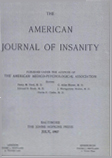Abstract
Neither brain weight alone, nor that measure together with such findings as excess of cerebrospinal fluid, shrunken appearance of gyri, widened sulci, etc., can serve for precise measurements of brain atrophy.
Such measurements and their correlation with clinical data become possible only when both cranial capacity and brain weight are taken into account.
The difference between cranial capacity, expressed in cubic centimeters, and brain weight, expressed in grams, and likewise the simple ratio between these data, are magnitudes which vary greatly under wholly normal conditions, owing to variations in the sizes of skulls and brains; neither is, therefore, adapted for use as a normal standard of the relationship between cranial capacity and brain weight.
The measure which most nearly approaches a normal constant is probably that of the average width of the space between the skull and the brain, the cranio-encephalic space.
An index of that space may be derived by subtracting the cube root of the brain volume from the cube root of the cranial capacity according to the following formula in which, as shown, the brain volume is calculated from the brain weight by dividing the latter by 1.037, the average specific gravity of the brain:
[See Equation in the PDF file]
This formula gives double the width of the space around a cube equivalent to the brain volume enclosed in a cube equivalent to the cranial capacity. The relation of this measure to the actual average width of the cranio-encephalic space, of course, cannot be constant, but must vary somewhat as the shape of the brain varies. Its variations are, however, apparently not so great as to impair its value for the study of brain atrophy in correlation with clinical data.
The material of the present study consists of measurements made in 452 cases which came to autopsy and of some clinical data pertaining to these cases.
The measurements comprise those of height, weight, cranial capacity, brain weight, and index of atrophy, i. e., index of the average width of the cranio-encephalic space calculated according to the formula given above.
The clinical data are: Age at time of death, clinical classification, duration of psychosis, and degree of mental deterioration expressed in terms of an arbitrary scale—A, B, C, D—as explained in Section II.
The more important results of the analysis of this material are:
1. The index of atrophy seems to vary somewhat with age, showing increase as age advances.
2. The index of atrophy seems also to vary with the state of nutrition, though not so clearly, showing apparently some increase in cases of emaciation.
3. In cases of insanity the index of atrophy varies with the clinical group: it is greatest in cerebral arteriosclerosis; it is greater in general paresis and in senile dementia than in dementia præcox.
4. There is close correlation between degree of mental delerioration observed clinically and index of atrophy determined at autopsy: that is to say, mental deterioration, of whatever nature, goes hand in hand with brain atrophy.
5. There is close correlation between duration of the deteriorating psychosis and index of atrophy.
Inasmuch as interest will naturally center on dementia præcox, rather than on psychoses occurring on a basis of coarser and better understood brain lesions, a special analysis of the data pertaining to that group has been undertaken with a view to determining the share of the atrophy which is in that connection to be attributed to senility or to emaciation.
6. This analysis has shown that if senile involution plays any part in the production of brain atrophy in dementia præcox, that part is but a slight one: the bulk of the atrophy is not due to it.
7. The analysis has also shown that emaciation, like senile involution, plays but an unimportant part, if any, in the production of brain atrophy in dementia præcox: the bulk of the atrophy is not due to it.
The conclusion is, therefore, drawn that dementia prœcox is associated in some way with changes in the brain which lead to atrophy.

